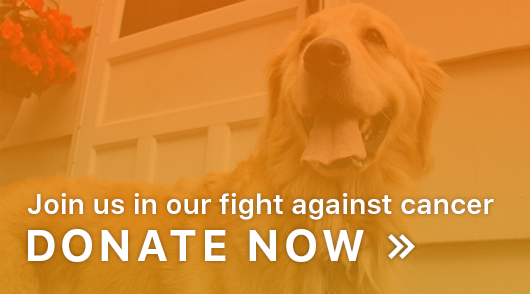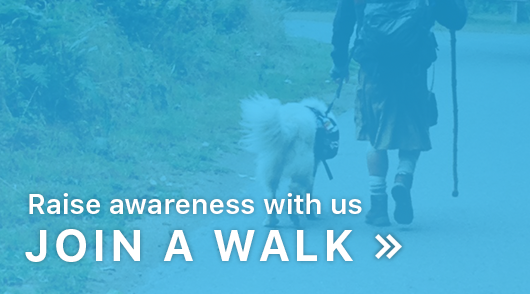
“Dogs do speak, but only to those who know how to listen.” — Orthan Pamuk
In This Issue: Only a Few More Hours to Vote in the 2019 Puppy Up Calendar Contest; PuppyUp Walks in September; Canine Lymphoma & Trials; Plan Escape Method for Pets; “My 10 years with Ginger Morgan”; Pup of the Month.
The 2019 Puppy Up Calendar Contest Is Almost Over!

We’re down to the wire. Just a few hours left until this year’s “Cancer Can’t Keep A Good Dog Down” 2019 Calendar Contest voting ends at 12:00 pm EDT on August 15th. (Any votes received after that time will be appreciated, but will not count towards the final tally.)
Please click on this link to find your favorite participants. They’re waiting for your votes.
Now more than ever we must continue the fight and support those with cancer, honor the friends we have lost, and raise funds for research that can help others. Please join us in our efforts to PuppyUp against cancer!
Questions or concerns? Technical issues? Please contact us at calendar@puppyup.org.

PuppyUp Walks in September
We have 2 PuppyUp Walks to look forward to in September, both on September 23rd.
PuppyUp New Paltz, NY
Join us at the 5th Annual PuppyUp New Paltz 2018! For more info, please follow this link.
Sunday, September 23rd
10 am – 3 pm
Please plan on being a part of the 5th annual PuppyUp New Paltz walk, once again in Adair Vineyards. We will walk together to promote awareness of canine cancer and fundraise for cancer research to benefit both pets and people.
PuppyUp Des Moines, IA
Sunday, September 23rd
Noon to 4 pm
Please join us for the 6th Annual PuppyUp Des Moines Walk at a new location: Raccoon River Park in West Des Moines as we promote awareness of canine cancer and fundraise for cancer research to benefit both pets and people. For more information on this walk, here’s the link.
To learn more about future walks, please follow this link. To learn how to start a walk in your area, click here.
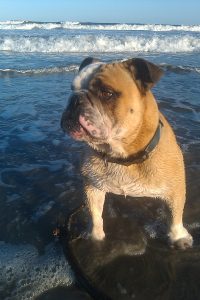
Canine Lymphoma and Trials
From Penn Vet
Non-Hodgkin’s lymphoma (NHL) is the most common cancer of the blood in dogs. It is a cancer of white blood cells known as lymphocytes and it occurs in lymphoid tissues such as the peripheral lymph nodes, spleen and bone marrow.
The disease frequently occurs in middle aged and older dogs (median age 6-9 years). Certain breeds are predisposed to lymphoma and include Boxers, Bull Mastiffs, Basset Hounds, Saint Bernards, Scottish Terriers, Airedales, and Bulldogs.
Most dogs with lymphoma develop enlarged lymph nodes, often felt as firm swellings underneath the jaw (submandibular lymphadenopathy), in front of the shoulder blades (prescapular lymphadenopathy) and/or behind the knees (popliteal lymphadenopathy). The most common subtype of NHL in dogs is Diffuse Large B-Cell Lymphoma.
Combinations of systemic chemotherapy drugs that inhibit cell division and kill rapidly dividing cells lead to clinical remission in approximately 75% of dogs. However, the majority of canine patients relapse with lethal, drug-resistant lymphoma within 6 to 9 months of diagnosis and treatment.
This statistic demonstrates that current therapies to treat canine B-NHL are insufficient to eliminate all the cancer cells and provide a “cure” for this disease.
Dr. Mason’s laboratory is working on two different immune therapy approaches to treat lymphoma. The first is aimed at preventing disease relapse in dogs that have been successfully treated with chemotherapy. The second approach is for dogs that have relapsed with lymphoma and are developing chemotherapy drug resistant disease.
An Immune Therapy Approach
Dr. Mason’s laboratory is working on an immune therapy approach to treat dogs that have relapsed with lymphoma and are developing chemotherapy drug resistant disease. In this approach to addressing canine lymphoma, immune cells (known as T cells) are taken from the peripheral blood, genetically modified in the laboratory to express a receptor that recognizes B cells, and then expanded to produce large numbers of tumor specific T cells outside of the body. These genetically modified T cells are then infused back into the body where they will seek out B cells and kill them. This process is known as adoptive immunotherapy and the cells that are infused into the patients are known as chimeric antigen receptor T cells (CAR T cells). This approach has shown dramatic results in human patients with leukemias at the School of Medicine at Penn and is now being adopted for use in dogs with lymphomas.
To read the rest of the story, please follow this link to our blog.
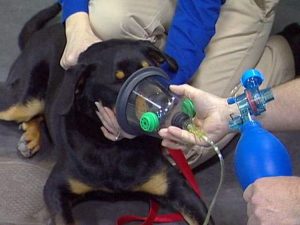
Smoke inhalation can be a real concern for pets including smoke from a fire or second-hand smoke.
Plan An Escape Method For Your Pets
(photo) Smoke inhalation can be a real concern for pets including smoke from a fire or second-hand smoke.
Brush fires from San Diego County to Northern California have burned tens of thousands of acres in 2018. Wind and low humidity during the summer months provide a dangerous combination, with dry brush fueling the flames. One cannot help but think about the animals, domestic and wild, who are also affected by these fires.
Daily, heroic animal control officers are navigating through dangerous and fiery terrain to assist residents and their pets. Regular shelters are taking in far more animals than usual and evacuation shelters are being filled to capacity as well.
Once rescued, most animals are requiring immediate medical attention due to smoke inhalation and burns.
Please be certain that you have a plan in place if your family should be faced with an emergency such as a house fire. Know ahead of time how you will transport your animals. Make sure that you have cages/crates to get animals out in a hurry. Make sure that you have several days’ worth of food, water, and medication if necessary, for your pets. Practice your emergency plan ahead of time.
Make sure your pets are micro-chipped in the event that you are separated. The American Veterinary Medical Association has named August 15th “Check The Chip Day” to remind pet owners to have their pets micro-chipped and to keep the registration information current.
Don’t wait. Nobody ever thinks an emergency evacuation will happen until it actually does.
This is also a good time to remind you of the dangers of second-hand smoke to pets.
Most people are well educated about the dangers of smoking. They understand the potential health risks involved every time they light up. They likely realize that these risks extend to nearby people who inhale their second-hand smoke. But do they know that second-hand smoke can similarly affect their cats, dogs, birds and other household companions? Do they understand that pets can suffer the negative health consequence of tobacco products by simply breathing the air circulating around their owners as they puff away?
Second-hand smoke is the smoke inhaled by non-smokers from one of two sources: the smoke produced by the burning end of a cigarette, cigar, or pipe OR the smoke exhaled by the smoker who inhaled it in the first place. Direct contact with a tobacco product is not necessary to be exposed to the dangers of smoking.
Living in a house with a smoker puts all types of pets at greater risk of many health problems.
Dogs exposed to second-hand smoke have more eye infections, allergies, and respiratory issues including lung cancer.
A study at Colorado State University demonstrated that dogs living in smoking environments also had an increased incidence of nasal cancer. Interestingly, the length of a dog’s nose is associated with the type of cancer incurred from inhaling second-hand smoke.
Long-nosed dogs are prone to nasal cancer while short-nosed dogs often get lung cancer. Long-nosed dogs such as Collies, Labradors, and Dobermans have increased surface area in their nasal canals. This increases the likelihood that toxins and carcinogens in tobacco smoke will be trapped in the nasal passages and accumulate in the nasal mucus. This explains why these breeds have a higher incidence of cancer in their nasal canals. In fact, the incidence of nasal tumors is 250 percent higher in long-nosed dogs living in smoke-filled environments.
For the rest of the article, please follow this link.
Pup of the Month — Belle White
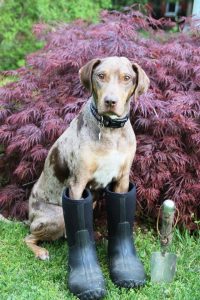
Belle White
(Suzanne White)
Meet Belle.
In October 2015, Belle (age 5) was diagnosed with a glioma brain tumor. A fast and deadly mass of nasty cells that affects both human and canine with dire prognosis.
We were fortunate to learn about a comparative oncology program at VA Tech, where new advancements in the human treatment of this cancer are used to care for our dogs first. As dogs share the same type of cancer, and their lives are significantly shorter than humans, they make ideal subjects and their human owners make ideal caretakers.
During this time, Belle remained at home with her family, and lived an additional 9 months as a happy and active dog. She ran, played and swam in the lake. We even entered an obedience trail and won first place. Belle and I would visit VA Tech regularly where Belle (always with a happy, albeit toothy smile), would be examined. Eventually the cancer won. We lost her in August of 2016.
BUT, For those nine months, Belle won! Nine months may not sound like a lot, but translate that to human time frame and that is 1 1/2 years of life. This was accomplished without major surgery or chemo. Brain cancer has replaced leukemia as the number one cause of cancer death for people UNDER THE AGE OF 20.
For all we loved Belle, but there was no cure we could offer her. With HOPE, Belle’s contribution is that someday, for some child…there will be a cure.
(Belle was a contestant in the 2018 Puppy Up Calendar Contest.)
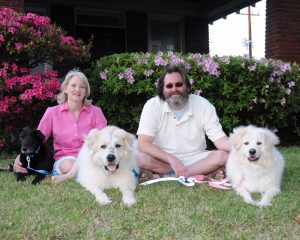
Ginger, Luke, Buddy, Murphy, and Hudson.
My 10 Years With Ginger Morgan
(Luke Robinson) The 150 mile stretch between Little Rock and West Memphis tested my mettle perhaps more than any other on my first cross country walk for canine cancer. Temperatures were spiking upwards of 100 with heat indices at suffocating levels such that the risk was too great for Hudson and Murphy.
I walked the Arkansas Delta alone and it was brutal. During the day biting horse flies attacked relentlessly along shadeless swampy country roads and at night a constant onslaught of mosquitoes swarmed me. I can still feel the chemical glow from all the DEET I sprayed on my body just to keep a perimeter from them. I rarely slept more than minutes at a time.
Walking into Memphis, I was beat up and beat down but damn glad to be there and then I met Ginger Morgan… (Read More)
We can always use your help. If you’re interested, send me an mail at ginger@puppyup.org.
Sincerely,
Ginger Morgan, Executive Director
The Puppy Up Foundation

